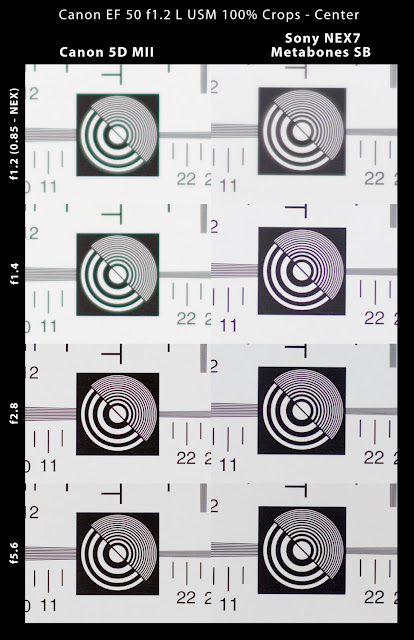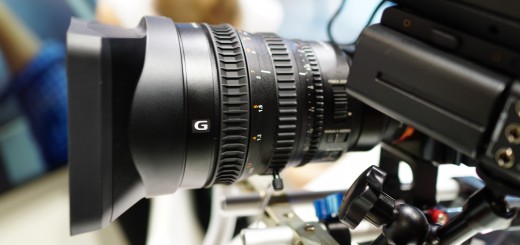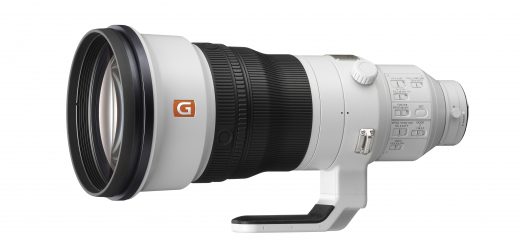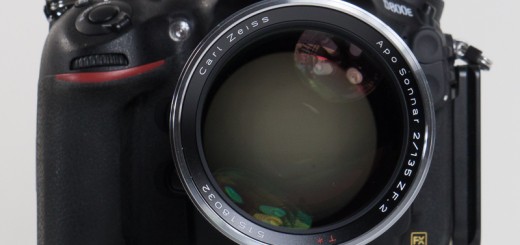Metabones Speed Booster Review (NEX 7) Part III – Canon EF 50 f1.2 L USM
Some photographers loves it, some hates it, it usually come to who owns it and who don’t.
Because, those who owns it for a longer period of time, learned about its severe flaws, but loves what they get in reward.In fact, it’s not a big deal. EF 50 f1.2 L has two main flaws – most of the aberrations is uncorrected, and there is significant focus shift.Uncorrected aberrations are part of lens design I am sure. This 50 is made to deliver smooth OOF rendering, ad slightly dreamy look wide open.Stopped down, lens can be very sharp, probably sharpest among Canon fifty. That reminds me of a classic old Sonnar design. Another current lens that behave alike, is Carl Zeiss Sonnar T* 50mm f1.5 ZM.Focus shift needs understanding and learning its way around, but for NEX users, with focus peaking and processed image in the viewfinder it’s much easier to get proper focus.
To use it with a Metabones Speed Booster, there is a magic appeal of resulting APS-C specification – 35.5mm and f0.85 !!! However, because of a pixel shading, resulting speed is slower. But pixel shading does not affect DOF, so with a speed booster you can have an image equivalent in terms of DOF to one made by FF at 53mm and f1.2.
Before Metabones Speed Booster, that was hardly possible.
 |
| Sony NEX 7, Metabones SB and Canon EF 50 f1.2 L USM at f0.85 (1.0 reported) |
Canon EF 50 f1.2 L USM is often used by pro videographers for its characteristics. For HD resolution the lens is still plenty sharp wide open, while focus subject are nicely isolated from the background. I am not using video on digital still cameras, but here is a short clip showing the DOF when re-focusing from the background to the foreground.
You might notice three thing – slight magenta cast over the frame, quite pronounced barrel distortion and my inability to focus properly at the end 🙂
I will write about magenta casting later on, but it is rather easy to correct. You will need to set-up white balance manually for every aperture though.
Distortion is much bigger problem. You can correct it in video, but you will loose some resolution, and correction is not that easy as with a still frame (depending on the situation). If you have such a static background, like I have here, it is easy. But if you will have moving people in front of your lens, you might not be able to do it, or if you do, it will take lot of time and effort. (Correction would have to be dynamic and nonlinear)
AF? Yes, AF can be used, but I am yet to find someone from my colleagues, who use it on the set. If you want to capture family moments, and you don’t mind focus breathing, it is possible, but I won’t suggest it it anyway.
Image comparisons
This time, I tried to include also images taken with a NEX 7 and Metabones Smart adapter. I thought it would be a good idea to see, how the image quality degrades on the same body.
It would be probably better to do so using ISO chart, but than it will be compromised by the short focus distance, so here are results from a field with a focus close to infinity.
First, let’s see, how differ FOV across the systems.
 |
| Sony NEX 7, Metabones SB and Canon EF 50 f1.2 L USM f5.6 FOV |
I don’t want to give you exact numbers here, because I didn’t have micro rail to adjust for the exact position of the sensor, but as an approximation, this is good enough I guess.
Before I show you crops, let me get back to that magenta cast from the video sample…
Here are two shots with Metabones SB. First is wide open, second – stopped f5.6
 |
| Sony NEX 7, Metabones SB and Canon EF 50 f1.2 L USM f0.85 above and f5.6 bellow |
As you can see, the problem is not color balance, but in overall vignetting that implied underexposure in the wide open shot. This is basically what pixel shading means and what it looks like. Because saturation is more pronounced in mid-tones and shadows, magenta cast is also more visible in the wide open shot.
Both shots were taken with Auto WB and they both have same temperature – 4750 K and Tint +1. If you however try to automatically adjust WB with a picker tool in LR 4.3, and you click at the same spot, you will get different temperatures.
For the still images, it is not a problem. For video it might be, because you will need to correct each take separately. The same apply for the exposure.
The effect of vignetting caused by pixel shading and by optics in SB can be seen in the following short clip
Let’s look at the 100% crops
All three alternatives wide open
 |
| Sony NEX 7, Metabones SB and Canon EF 50 f1.2 L USM wide open 100% crops |
I was surprised to see, that Metabones SB in this case didn’t improve center resolution, as it was a case with TS-E 17. Extreme corners are bad, but edges are quite ok.
The overall effect, looks like a “blooming” effect and I believe designers confirmed that. But this f stop will be rarely used in photography at such a long distances. So let’s see how they compare at more reasonable f4.
 |
| Sony NEX 7, Metabones SB and Canon EF 50 f1.2 L USM at f4 100% crops |
Center sharpness improved a lot, blooming is almost gone, but extreme corners are still mushy and vignetting started to be more pronounced.
Here are 100% crops from the ISO chart of Sony NEX 7 with Metabones SB
 |
| Sony NEX 7, Metabones SB, Canon EF 50 f1.2L USM, ISO chart 100% crops |
And here are few comparisons at wide open, f1.4, f2.8 and f5.6 against Canon 5D Mark II
You should enlarge images to their original sizes, to see, that Metabones SB with NEX 7 really improves center resolution wide open and at f1.4. Therefore the differences in a field result test could be due to the not precise focusing or different behavior at longer distances.
At f5.6 and above, cropping will be necessary due to the hard vignetting in corners.
 |
| Sony NEX 7, Metabones SB and Canon EF 50 f1.2 L USM variable apertures – vignetting |
Here are few samples of OOF areas at wide open aperture. The focus plane was moved across the scene, so that you can judge front and back OOF areas.
Conclusion:
If there is a reason to use Canon EF 50 f1.2 L with Metabones Speed Booster on NEX body, it should be about shallow DOF.
But, it starts to be more and more clear, that Metabones Speed Booster is not such a miracle, as it might look from the recent hype.
There is pronounced distortion and PF. Pixel shading makes attractive lens speed… well, shaded… The resulting underexposure and pronounced color casting are problems that photographer can deal with. Not so much videographer, or at least, not that easy.
Blooming at wide aperture, makes image a bit dreamy, and it would be nice for portraits, if 50mm is your FL.
Hard vignetting from f5.6 and up, involve the necessity for cropping.
I start to look at MB speed Booster as an adapter for UWA and WA lenses up to some
35 mm. Of course, I tested so far one of the lenses with biggest projection circle on FF (TS-E 17), so I have to see, how other “normal WA will perform. From some initial tests that I have done with EF 24 f1.4 L II, results looks promissing.
But above 35, Speed Booster has to be seriously thought off, before you click and buy it. There is Sony SEL 35 f1.8 for less than SB, that will give you similar FOV on NEX and DOF of some f2.8 FF equivalent. That is good enough for most things, especially if you use image stabilization and AF. There is also Mitakon and SLR Magic with 35 f0.95, that we have to see yet, but they are not much more expensive than Speed Booster.
If the shallow DOF is what you are after, than SB with Canon EF 50 f1.2 L on NEX, will most probably please you. For anything else, there are better options at this FL.
Links to the part I of the review – Metabones Speed Booster – Part I Introduction
Links to the part II of the review – Metabones Speed Booster – Part II – with Canon TS-E 17 f4 L
Buy on BHPhoto: EF 50mm f/1.2L USM Lens
Buy on Amazon: EF 50mm f/1.2L USM Lens
To help this page survive, your donation will be highly appreciated.

























Still cheaper than buying new lens.. or well, some of them. 😀
Results from 50/1.2L are not that bad, still seems pretty usable. And there are pretty much no lens that have same style as 50/1.2L (well, maybe Fujinon EBC 50/1.4, but its not same :).
Hello,
many thanks for the review! Any chance to test one of your Pentax PK lenses with a Pentax K to Canon EF adapter? 🙂 It would be great if that could work! Of course without AF and A Mode, but it would give me the opportunity to use my old Pentax lenses @ FF (without aperture lever modification).
Many thanks!
Hi Andrew,
I am afraid that I don’t have Pentax K to EF adapter 🙁 I will have to double check, but I think I never had one. However it shoul be possible, but with some caution. On their web, Metabones says that there are problems with some Olympus OM and Leica R. In general, I think that lenses with protruded last element are problematic, because of the Metabones optical element.
Hello Viktor,
Your efforts are much appreciated! I’m hoping for Pentax FF or kind of. 😉 However, I have found this on Flickr:
http://www.flickr.com/photos/vivek-iyer/8439155370/
Some modifications are needed for those scary Olympus OM lenses with additional mount parts or flange, which you can see in this photo:
http://i44.photobucket.com/albums/f9/shall19/joescameras/zuiko28mm_O_03.jpg
Well, the Olympus OM 50/1.2 do not have such a (center) flange … :
http://forum.getdpi.com/forum/attachments/gear-fs-wtb/56144d1332034872-fs-olympus-om-zuiko-50mm-f-1-2-lens-p1310320_1024.jpg
… and seems to work fine. That makes me a bit optimistic about the Pentax lenses because – like the OM 50/1.2 – all levers and stuff are on the outside. And the Tokina made PK lenses have just a lever and no flange:
http://wycameras.com/wp-content/uploads/2013/01/Tokina-PK-80-200-lens-3_2012-01-30.jpg
Hope that helps someone! Thanks again!
Thank you for useful informations. I might order Pentax K to EF mount and give it a try.
Fantastic find this blog of yours.
I’ve done a very unscientific review of the Lens Turbo Canon FD adaptor. I’d appreciate your input and perhaps guidelines on how I could perform some better tests… better than that, it would be awesome if you got hold of one yourself and posted your findings and comparisons. So far I’m very happy with it… though not flawless by any means its given some life to my canon FD 50mm 1.4 and 20mm 2.8.
I have the Mitakon 35mm f0.95 and use it for only black and white stills as it suffers greatly from pixel shading wide open, having an effective T stop of around 1.4 as well as a very strong colour cast. The lens coatings seem very weak so then lens also suffers from flare, poor colour and very noticeable colour fringe around any contrasting edges. In black and white it is very sharp in the centre but falls off quickly in the corners and exhibits pronounced field curvature. The lens feels well built, heavy and smooth to focus. Aperture is step less, although the depth of field is shallow, veiling wide open makes it tricky to focus without magnification and the bokeh is inconsistent, sometimes looking lovely and smooth, then other times when there are repeating patterns or specular highlights, busy and just generally messy. So my advice is to look elsewhere for a fast lens for video.
Here are some examples from the lens, some are available at full resolution.
http://www.flickr.com/photos/adamjasonmoore/sets/72157632170405500/
I have the also have the Speedbooster and 50mm f1.2L which although not perfect gives me a much better looking shallow depth of field shot. I have been testing other lens with the speedbooster at my local camera store, while testing various Canon L and Zeiss lenses to see how well they play with the adapter, I tried the new Sony 35mm f1.8 OSS which for the money is excellent.
Thanks for taking the time to share your own experiments with the adapter and lens combinations, keep up the good work and please share any super combinations you find in the future.
I have a similar setup with Canon 50mm f1.2L on Metabones EF to NEX speed booster on a 16mp NEX body. The difference is I am using a NEX 5r. No matter how I stop down the aperture on the 50mm to maximum f11, I cannot get the image to hard vignett. Is it possible different speed boosters are manufactured differently?
Metabones didn’t announce a word about changing its original design of EF/E speed booster. There is probably newer firmware, but that won’t affect hard vignetting. Most probable cause that emphesize or reduce vignetting effect is adjustment of the rear glass element in irder to achieve infinity focus with some lenses. At different settings, this element cause different amount of vignetting. If you have only EF 50/1.2L and you can focus on the infinity withous seeing vignetting – good for you.
Cheers,
Viktor
Thanks for review, it was excellent and very informative.
thank you 🙂
WOW. I ll donate for that post. I just got the a6000 and I don’t know if I should get the SB for my 50 1.2 or if I should just sell my 50 and get the Sony 35 1.8 0ss.
I am torn between the outstanding low DOF of the 50 1.2 and the small size (for street photography) and IS of the 35.
In case I want to keep my 50 I will have to spend an additional 650$ on the SB. While switching to the 35 brings money back to my pocket.
So I guess I am better of letting go the outstanding low DOF :_(
Hi Mario,
I sent you link with an overview of three focal reducers, in the reply to your previous post. I think that article might be of an interest for you, as lens Turbo II is much cheaper than Metabones Speed Booster Ultra. (149 USD).
Cheers,
Viktor